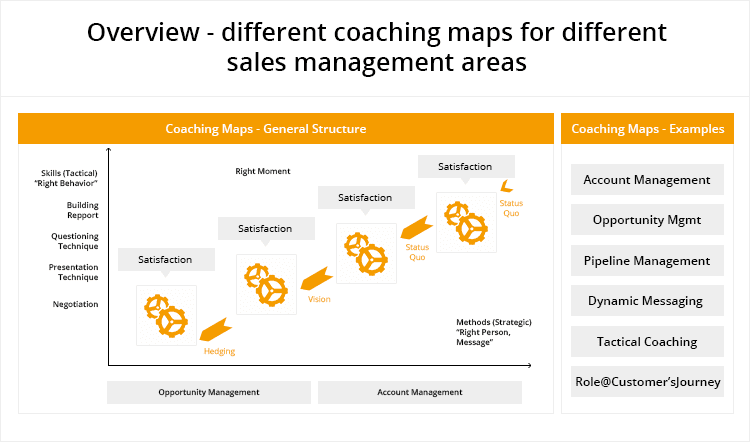Picture this: It’s Sam’s first day on the job as a sales enablement manager for Fast Growth Inc., a rapidly expanding tech company, and he’s feeling daunted, to say the least. He’s Fast Growth Inc.’s first-ever enablement specialist. There’s a lot to be done to improve sales productivity and equip the sales reps, and it’s overwhelming for him to decide where to start. It would be easy to spin his wheels for the first few months, but Fast Growth Inc. is on a fast trajectory and are keen to see some quick results. Sound familiar?
This scenario is one that many sales enablement leaders have either faced in their careers or currently face. But not to worry, we’re here to help Sam (and you) get the most out of the next 90 days. Here’s where to start:
1. Audit rep’s sales readiness
To date, Fast Growth Inc.’s approach to sales readiness has been ad hoc, which is no surprise given their team has grown quickly and is planned to expand from 25 to 100 in the next six months. There’s a ton of product and buyer information in wiki documents, emails, and PDFs that grows each week as new product features and bug fixes are introduced. On top of that, each sales manager has their own way to train and keep their staff up to speed. But there’s no standard way to determine whether the sales reps have absorbed all this information, identify what knowledge gaps they have, and if they’re actually really sales ready.
By conducting an audit of all the existing training and product content for both new and seasoned reps, Sam can see where there may be content gaps, and also determine if there is perhaps some content that the sales reps don’t really consume at all. It may be in a format that is not engaging or difficult to understand, or perhaps it’s not really relevant to them at all. At this stage, it’s important for Sam to look at the existing training content objectively, and decide what really is the most important information for these sales reps. For example, as Fast Growth Inc. is a SaaS business it will be most helpful for the reps to have access to use case studies, whereas if it was into big data perhaps detailed training on product features would be more relevant to them.
As part of this process, Sam will also need to identify who owns what content. It’s quite possible there’s some content that doesn’t have clear accountability at all, and Sam may have to broker responsibility for it to ensure that all the relevant information is shared regularly. He’ll need to look beyond the sales managers and build relationships with other business units that may have information that should be included in the sales training content, like the product, marketing, and the customer success teams. These relationships will continue to be important as his role develops over time, with Sam becoming a critical link between the sales reps and these parts of the business.
Once Sam has audited all of the content, he can look at how it’s set out and determine if there is a better way to structure the sales training so that it’s more robust. One of the best ways to look at how effective the training is to use a data-driven approach. Can he measure how knowledgeable a sales rep is once they’ve completed the training? How engaged are they with the training? Is the information in a format that is easily consumed by sales reps, or does the delivery of it need to be improved?
By looking at the training materials objectively, Sam can then identify what the most important information required is and prioritize that. Like with most things, 20% of the content required for sales training should deal with about 80% of the situations faced by sales reps, so having these easily accessible to them should be priority number 1 for Sam.
With so many new reps coming in Fast Growth Inc.’s doors in the next few months, it’s also important that he considers the sales onboarding program and how that should be structured as part of the overall sales training for the company.
2. Enable managers to coach better
The sales managers at Fast Growth Inc have been responsible for both training and coaching the sales reps, but this has changed now with Sam coming on board. The training will be managed by Sam. This doesn’t mean the sales managers aren’t involved though, Sam takes Sales managers to help by recording their pitches, success stories etc.
While the role of coaching sales reps is still left to the sales manager, Sam ~~ equip them with tools that will help them, coach, more efficiently. This should then free up the sales managers so that they can spend more of their valuable time on coaching complex scenarios and advanced problems like objection handling.
The first step Sam can take here is by putting in place the elements to enable sales managers to implement a structured coaching program for their reps. This should at least cover the basics of Sales 101 like prospecting and pitching, using quizzes or certifications that identify where reps have skill gaps so that he can then determine what specific areas their coaching plan should focus on.
One of the best ways to do this is by creating coaching maps for each stage of the sales process and then developing tools or exercises that the sales manager can select to coach their reps in different areas. For example, to coach reps who are struggling to define their value proposition to a customer, Sam can set up an exercise where the rep can record themselves doing a pitch and this can then be reviewed by the sales manager in the coaching session. By setting up a range of tools and exercises like this, the sales manager can then easily implement a structured coaching plan for individual reps.
 Ref: Tamara Schenk webinar on “How to equip your sales managers”
Ref: Tamara Schenk webinar on “How to equip your sales managers”
With sales managers free to coach on more complex issues, and sales reps’ skill gaps being addressed, there should be a marked change in win rates and sales results. In fact, CSO Insights research indicates that 62.4% of reps will make a plan if there’s a formal plan in place compared to just 53.1% where there’s no coaching plan. Furthermore, an additional 10% of quota will be achieved when a formal plan is in place, which is a great quick win for Sam.
3. Create a sales enablement framework
The final thing that Sam can do in his first few months on the job is to create a robust data driven sales enablement framework. This involves looking at what the sales reps and managers must do in their roles at every stage of the sales process, identify what they need to be able to complete these tasks effectively.
The framework should cover everything from the type of sales collaterals they need, to the tools and technology they use to complete their job. Once Sam has mapped this out for each part of the sales process, he should then ask himself whether the sales reps (and managers) have enough information at each stage of the process to have a meaningful discussion with a prospect. If he concludes that they don’t, then he will need to identify what is required to fill that gap and enable the sales rep.
The gaps in the sales enablement framework could be sales collateral, access to product updates, industry or competitor information, or an understanding of how to use the CRM. In some instances, the information may exist but it may not be readily accessible to the sales rep when they need it, so perhaps mobile sales enablement is a priority. In simple terms, the purpose of sales enablement is to make it easier for sales reps and managers to do their job at any point in time, and this should be the focus of the sales enablement framework.
By achieving these three things, Sam will be able to show the VP of Sales that the sales team is more productive and sales ready than they were three months ago. The next stage for Sam will be to plug the gaps he’s identified in the sales enablement framework and build on the great work he’s started in his first 90 days.








